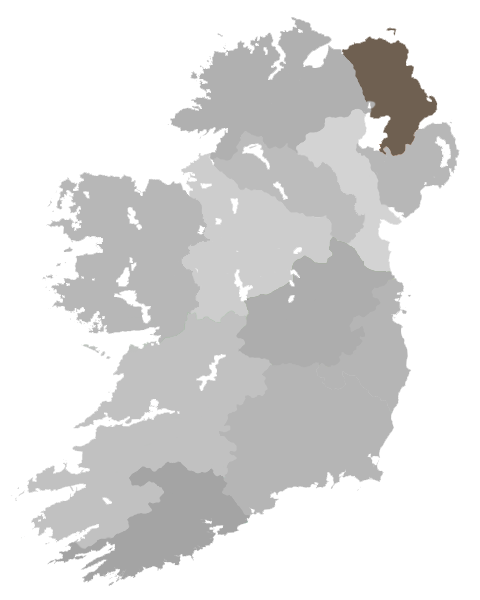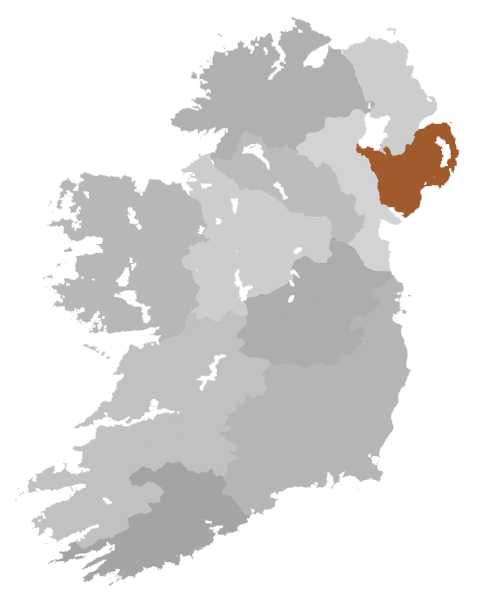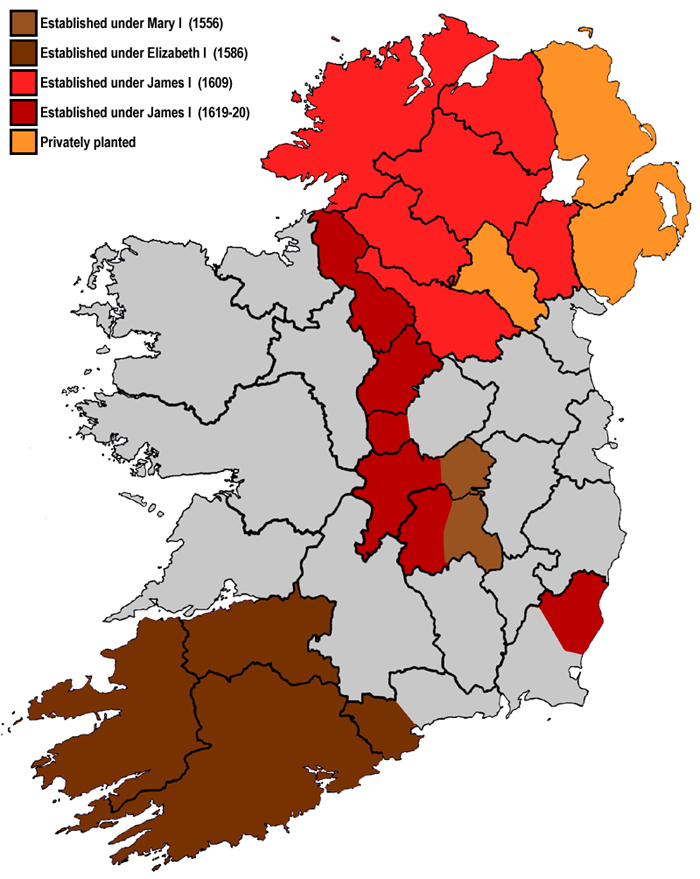|
Diocese Of Connor (Church Of Ireland)
The Diocese of Connor is in the Province of Armagh of the Church of Ireland. Overview and history Christianity has been present in Connor Diocese for over 1500 years. Tradition holds that St. Patrick herded sheep on Slemish, in the heart of the Diocese, when first brought to Ireland as a slave. Saint Malachy, the great reformer of the Irish church, was consecrated Bishop of Connor in 1124 and remained until his translation to the Archbishopric of Armagh in 1132. The see was originally at Connor, County Antrim, Connor. There is much evidence, from written sources and archaeological material, that Connor was a sizeable, complex settlement in the Early Christian period, probably with monastic and secular elements coexisting. There was no monastic establishment at Connor in the Middle Ages, though there was an Augustinians, Augustinian community at Kells, County Antrim, Kells nearby. When the Church in England broke communion with the Roman Catholic Church, the Church of England wa ... [...More Info...] [...Related Items...] OR: [Wikipedia] [Google] [Baidu] |
Roman Catholic Church
The Catholic Church, also known as the Roman Catholic Church, is the largest Christian church, with 1.3 billion baptized Catholics worldwide . It is among the world's oldest and largest international institutions, and has played a prominent role in the history and development of Western civilization.O'Collins, p. v (preface). The church consists of 24 ''sui iuris'' churches, including the Latin Church and 23 Eastern Catholic Churches, which comprise almost 3,500 dioceses and eparchies located around the world. The pope, who is the bishop of Rome, is the chief pastor of the church. The bishopric of Rome, known as the Holy See, is the central governing authority of the church. The administrative body of the Holy See, the Roman Curia, has its principal offices in Vatican City, a small enclave of the Italian city of Rome, of which the pope is head of state. The core beliefs of Catholicism are found in the Nicene Creed. The Catholic Church teaches that it is th ... [...More Info...] [...Related Items...] OR: [Wikipedia] [Google] [Baidu] |
Latin Rite
Latin liturgical rites, or Western liturgical rites, are Catholic rites of public worship employed by the Latin Church, the largest particular church ''sui iuris'' of the Catholic Church, that originated in Europe where the Latin language once dominated. Its language is now known as Ecclesiastical Latin. The most used rite is the Roman Rite. The Latin rites were for many centuries no less numerous than the liturgical rites of the Eastern Catholic Churches, Eastern autonomous particular churches. Their number is now much reduced. In the aftermath of the Council of Trent, in 1568 and 1570 Pope Pius V suppressed the breviary, breviaries and missals that could not be shown to have an antiquity of at least two centuries (see Tridentine Mass and Roman Missal). Many local rites that remained legitimate even after this decree were abandoned voluntarily, especially in the 19th century. In the second half of the 20th century, most of the religious orders that had a distinct liturgical rit ... [...More Info...] [...Related Items...] OR: [Wikipedia] [Google] [Baidu] |
Diocese Of Down And Dromore
The Diocese of Down and Dromore (also known as the United Dioceses of Down and Dromore) is a diocese of the Church of Ireland in the south east of Northern Ireland. It is in the ecclesiastical province of Armagh. The geographical remit of the diocese covers half of the City of Belfast to the east of the River Lagan and the part of County Armagh east of the River Bann and all of County Down. Overview and history When the Church in England broke communion with the Roman Catholic Church, the Church of England was established by the state as the established church. Later, by decree of the Irish Parliament, a similar new body became the State Church in the Kingdom of Ireland. The English-speaking minority mostly adhered to the Church of Ireland or to Presbyterianism. On the death of Archbishop Trench of Tuam in 1839, the Province of Tuam was united to the Armagh. Over the centuries, numerous dioceses were merged, in view of declining membership. Until 1944, the dioceses of Down and ... [...More Info...] [...Related Items...] OR: [Wikipedia] [Google] [Baidu] |
Lisburn
Lisburn (; ) is a city in Northern Ireland. It is southwest of Belfast city centre, on the River Lagan, which forms the boundary between County Antrim and County Down. First laid out in the 17th century by English and Welsh settlers, with the arrival of French Huguenots in the 18th century, the town developed as a global centre of the linen industry. In 2002, as part of Queen Elizabeth's Golden Jubilee celebrations, the predominantly unionist borough was granted city status alongside the largely nationalist town of Newry. With a population of 45,370 in the 2011 Census. Lisburn was the third-largest city in Northern Ireland. In the 2016 reform of local government in Northern Ireland Lisburn was joined with the greater part of Castlereagh to form the Lisburn City and Castlereagh District. Name The town was originally known as ''Lisnagarvy'' (also spelt ''Lisnagarvey'' or ''Lisnagarvagh'') after the townland in which it formed. This is derived . In the records, the nam ... [...More Info...] [...Related Items...] OR: [Wikipedia] [Google] [Baidu] |
Protestant
Protestantism is a Christian denomination, branch of Christianity that follows the theological tenets of the Reformation, Protestant Reformation, a movement that began seeking to reform the Catholic Church from within in the 16th century against what its followers perceived to be growing Criticism of the Catholic Church, errors, abuses, and discrepancies within it. Protestantism emphasizes the Christian believer's justification by God in faith alone (') rather than by a combination of faith with good works as in Catholicism; the teaching that Salvation in Christianity, salvation comes by Grace in Christianity, divine grace or "unmerited favor" only ('); the Universal priesthood, priesthood of all faithful believers in the Church; and the ''sola scriptura'' ("scripture alone") that posits the Bible as the sole infallible source of authority for Christian faith and practice. Most Protestants, with the exception of Anglo-Papalism, reject the Catholic doctrine of papal supremacy, ... [...More Info...] [...Related Items...] OR: [Wikipedia] [Google] [Baidu] |
Jeremy Taylor
Jeremy Taylor (1613–1667) was a cleric in the Church of England who achieved fame as an author during the Protectorate of Oliver Cromwell. He is sometimes known as the "Shakespeare of Divines" for his poetic style of expression, and he is frequently cited as one of the greatest prose writers in the English language. He is remembered in the liturgical calendars of the Church of England and the Episcopal Church of the United States. Taylor was under the patronage of William Laud, Archbishop of Canterbury. He went on to become chaplain in ordinary to King Charles I as a result of Laud's sponsorship. This made him politically suspect when Laud was tried for treason and executed in January 1644/5 by the Puritan parliament during the English Civil War. After the parliamentary victory over the King, he was briefly imprisoned several times. Eventually, he was allowed to live quietly in Wales, where he became the private chaplain of the Earl of Carbery. After the Restoration, he was ... [...More Info...] [...Related Items...] OR: [Wikipedia] [Google] [Baidu] |
Episcopacy
A bishop is an ordained clergy member who is entrusted with a position of authority and oversight in a religious institution. In Christianity, bishops are normally responsible for the governance of dioceses. The role or office of bishop is called episcopacy. Organizationally, several Christian denominations utilize ecclesiastical structures that call for the position of bishops, while other denominations have dispensed with this office, seeing it as a symbol of power. Bishops have also exercised political authority. Traditionally, bishops claim apostolic succession, a direct historical lineage dating back to the original Twelve Apostles or Saint Paul. The bishops are by doctrine understood as those who possess the full priesthood given by Jesus Christ, and therefore may ordain other clergy, including other bishops. A person ordained as a deacon, priest (i.e. presbyter), and then bishop is understood to hold the fullness of the ministerial priesthood, given responsibility b ... [...More Info...] [...Related Items...] OR: [Wikipedia] [Google] [Baidu] |
Covenanter
Covenanters ( gd, Cùmhnantaich) were members of a 17th-century Scottish religious and political movement, who supported a Presbyterian Church of Scotland, and the primacy of its leaders in religious affairs. The name is derived from ''Covenant'', a biblical term for a bond or agreement with God. The origins of the movement lay in disputes with James VI, and his son Charles I over church structure and doctrine. In 1638, thousands of Scots signed the National Covenant, pledging to resist changes imposed by Charles on the kirk; following victory in the 1639 and 1640 Bishops' Wars, the Covenanters took control of Scotland and the 1643 Solemn League and Covenant brought them into the First English Civil War on the side of Parliament. Following his defeat in May 1646 Charles I surrendered to the Scots Covenanters, rather than Parliament. By doing so, he hoped to exploit divisions between Presbyterians, and English Independents. As a result, the Scots supported Charles in the 16 ... [...More Info...] [...Related Items...] OR: [Wikipedia] [Google] [Baidu] |
Presbyterian
Presbyterianism is a part of the Reformed tradition within Protestantism that broke from the Roman Catholic Church in Scotland by John Knox, who was a priest at St. Giles Cathedral (Church of Scotland). Presbyterian churches derive their name from the presbyterian polity, presbyterian form of ecclesiastical polity, church government by representative assemblies of Presbyterian elder, elders. Many Reformed churches are organised this way, but the word ''Presbyterian'', when capitalized, is often applied to churches that trace their roots to the Church of Scotland or to English Dissenters, English Dissenter groups that formed during the English Civil War. Presbyterian theology typically emphasizes the sovereignty of God, the Sola scriptura, authority of the Scriptures, and the necessity of Grace in Christianity, grace through Faith in Christianity, faith in Christ. Presbyterian church government was ensured in Scotland by the Acts of Union 1707, Acts of Union in 1707, which cre ... [...More Info...] [...Related Items...] OR: [Wikipedia] [Google] [Baidu] |
Scotland
Scotland (, ) is a country that is part of the United Kingdom. Covering the northern third of the island of Great Britain, mainland Scotland has a border with England to the southeast and is otherwise surrounded by the Atlantic Ocean to the north and west, the North Sea to the northeast and east, and the Irish Sea to the south. It also contains more than 790 islands, principally in the archipelagos of the Hebrides and the Northern Isles. Most of the population, including the capital Edinburgh, is concentrated in the Central Belt—the plain between the Scottish Highlands and the Southern Uplands—in the Scottish Lowlands. Scotland is divided into 32 administrative subdivisions or local authorities, known as council areas. Glasgow City is the largest council area in terms of population, with Highland being the largest in terms of area. Limited self-governing power, covering matters such as education, social services and roads and transportation, is devolved from the Scott ... [...More Info...] [...Related Items...] OR: [Wikipedia] [Google] [Baidu] |
Plantations Of Ireland
Plantations in 16th- and 17th-century Ireland involved the confiscation of Irish-owned land by the English Crown and the colonisation of this land with settlers from Great Britain. The Crown saw the plantations as a means of controlling, anglicising and 'civilising' Gaelic Ireland. The main plantations took place from the 1550s to the 1620s, the biggest of which was the plantation of Ulster. The plantations led to the founding of many towns, massive demographic, cultural and economic changes, changes in land ownership and the landscape, and also to centuries of ethnic and sectarian conflict. They took place before and during the earliest English colonisation of the Americas, and a group known as the West Country Men were involved in both Irish and American colonization. There had been small-scale immigration from Britain since the 12th century, after the Anglo-Norman invasion. By the 15th century, direct English control had shrunk to an area called the Pale. In the 1540s t ... [...More Info...] [...Related Items...] OR: [Wikipedia] [Google] [Baidu] |
Plantation Of Ulster
The Plantation of Ulster ( gle, Plandáil Uladh; Ulster-Scots: ''Plantin o Ulstèr'') was the organised colonisation (''plantation'') of Ulstera province of Irelandby people from Great Britain during the reign of King James I. Most of the settlers (or ''planters'') came from southern Scotland and northern England; their culture differed from that of the native Irish. Small privately funded plantations by wealthy landowners began in 1606, while the official plantation began in 1609. Most of the colonised land had been confiscated from the native Gaelic chiefs, several of whom had fled Ireland for mainland Europe in 1607 following the Nine Years' War against English rule. The official plantation comprised an estimated half a million acres (2,000 km2) of arable land in counties Armagh, Cavan, Fermanagh, Tyrone, Donegal, and Londonderry. Land in counties Antrim, Down, and Monaghan was privately colonised with the king's support. Among those involved in planning and ov ... [...More Info...] [...Related Items...] OR: [Wikipedia] [Google] [Baidu] |

.jpg)







